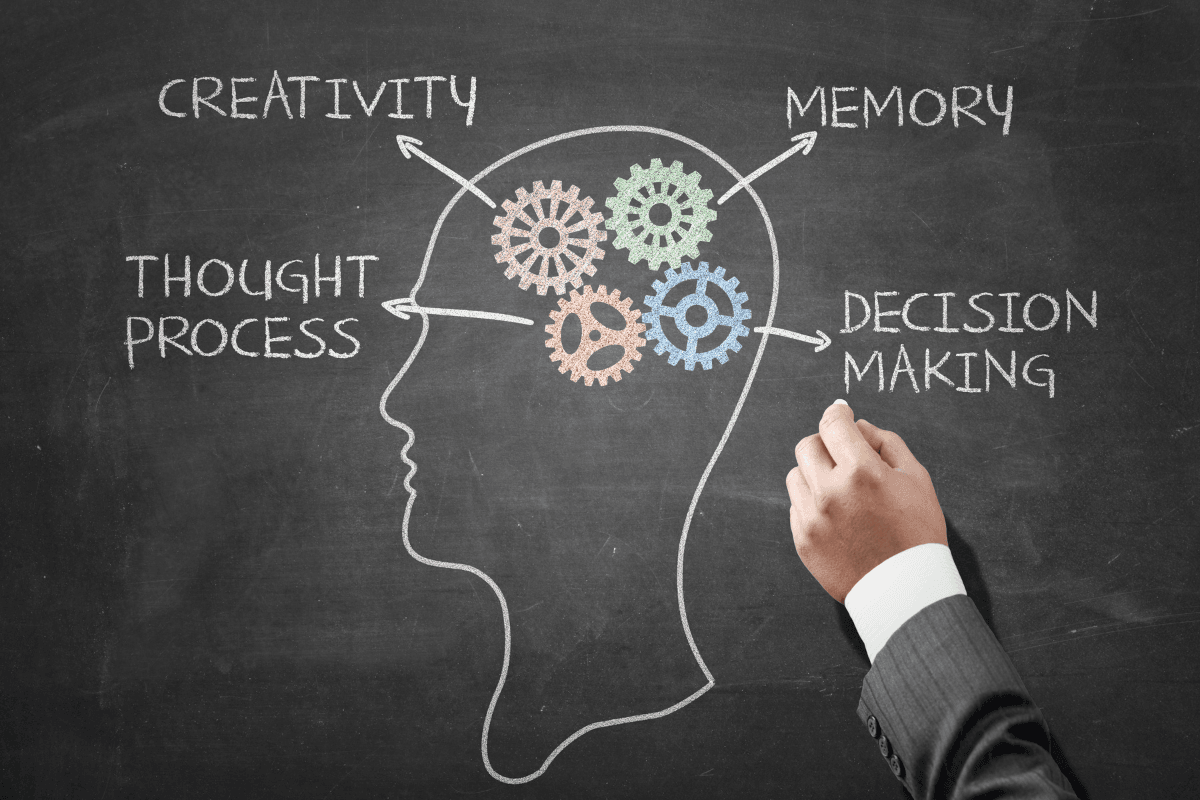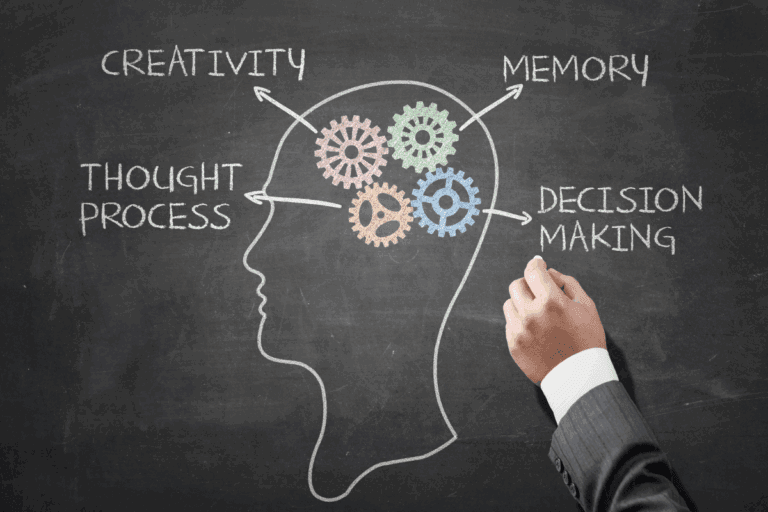Are distractions at work preventing you from achieving your goals? You’re not alone—many people struggle to stay focused amidst constant interruptions. This article will share effective strategies to minimize distractions, such as implementing the Pomodoro technique and organizing your workspace.
By following these tips, you’ll increase your productivity and create a healthier work environment. If you’re looking to tackle the challenges of concentration and maximize your output, keep reading for practical solutions and actionable feedback to help you stay focused at work and transform your workday.
Struggling to Stay Focused at Work? Here’s How to Fix That!
Set Clear Goals to Stay Focused at Work

Defining SMART goals can supercharge your focus at work, offering clarity and direction. Breaking down projects into manageable tasks helps you tackle distractions effectively.
Using goal-tracking tools keeps you accountable and on track. Each of these strategies will enhance your productivity, ensuring you stay aligned with your objectives and minimize interruptions throughout your day.
Define SMART Goals to Enhance Clarity
When you set SMART goals—specific, measurable, achievable, relevant, and time-bound—you create a clear direction that can significantly optimize your attention span.
For instance, if you are working on a project involving language refinement, instead of saying, “I’ll improve my writing,” you might set a goal like, “I will revise my report by Friday, focusing on clarity and conciseness.”
This approach helps you stay on track and minimizes distractions since you know exactly what you need to accomplish by when.
Having clearly defined goals allows you to use your computer effectively, empowering you to manage your time and tasks better. When distractions arise, you can quickly recalibrate your focus on your current objectives, enhancing your productivity.
As you refine your goals, consider breaking larger tasks into smaller, actionable steps, which can keep you engaged and reduce the urge to get sidetracked by unrelated interruptions.
Break Down Projects Into Manageable Tasks
Breaking down projects into manageable tasks can significantly enhance your focus at work. When you divide a larger project into smaller steps, you not only make it less overwhelming for yourself, but you also improve your mood as you accomplish these smaller goals.
For example, if you’re tasked with a software upgrade at your workplace, break it down into steps such as research, installation, and testing. This keeps employees engaged and prevents distractions, allowing you to stay on course.
Utilizing technology tools can help you track these smaller tasks effectively. There are plenty of applications designed for project management that enable you to assign tasks and deadlines.
By actively using these tools, you keep everyone in the loop and avoid the confusion that can arise from multitasking. This structured approach not only boosts productivity but also creates a positive work environment, minimizing interruptions and facilitating a smoother workflow.
Use Goal-Tracking Tools for Accountability
Using goal-tracking tools can really help you stay accountable in your work environment. When you set clear goals and track your progress, you cultivate a sense of structure that can lead to improved relaxation and energy levels throughout your day.
For instance, if you’re working on a project, using apps like Trello or Asana can remind you of your deadlines and tasks, prompting you to maintain focus and ensure that sleep and stress don’t interfere with your productivity.
These tools also allow you to celebrate small achievements along the way, which can boost your motivation. As an employee, when you check off completed tasks, you might find that your focus sharpens and you’re less inclined to get sidetracked.
This approach not only keeps you on track but also helps create a healthier work-life balance, providing you with the clarity you need to stay engaged without burning out.
Once you set your goals, it’s time to decide what really matters. Prioritizing your tasks will sharpen your focus and guide your actions toward success.
Prioritize Your Tasks for Better Focus
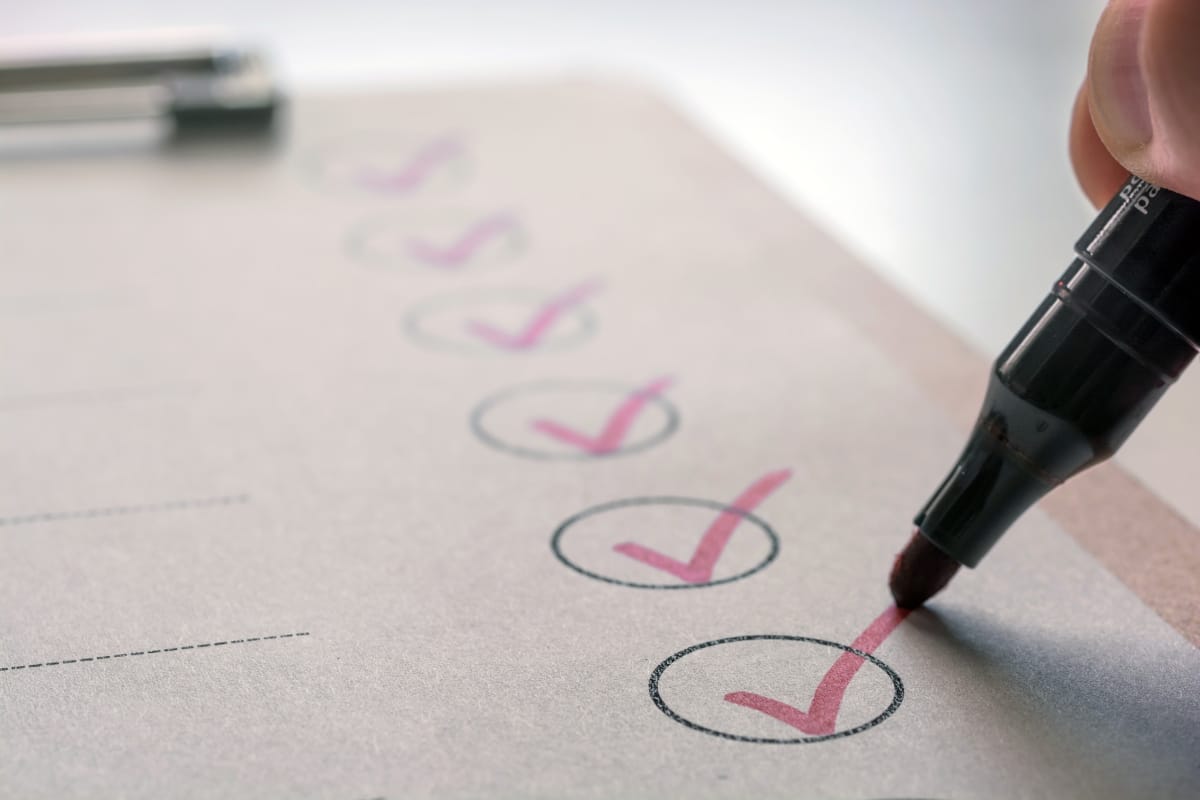
Understanding the difference between urgent and important tasks is crucial for effective time management. You can utilize the Eisenhower Matrix to streamline your task management by ranking your responsibilities based on deadlines and impact.
This method not only enhances your health and well-being but also provides valuable information that can help you focus better on what really matters. Let’s explore these strategies in detail!
Identify Urgent vs. Important Tasks
Understanding the difference between urgent and important tasks can significantly enhance your workflow. Urgent tasks demand immediate attention, while important tasks contribute to long-term goals and skill development.
By recognizing what truly matters, you can better allocate your time, spend less time on distractions, and focus on activities that foster growth and learning in your role.
To effectively prioritize, consider using a simple method: ask yourself whether a task is urgent or important. For instance, responding to emails may seem urgent but not always important for your long-term objectives.
By identifying these tasks, you’ll create a clearer workflow and reduce stress, allowing you to enjoy that cup of caffeine without feeling overwhelmed. This approach helps you stay focused and aligned with your essential goals.
Utilize the Eisenhower Matrix for Task Management
The Eisenhower Matrix is a powerful tool to help you prioritize tasks effectively and reduce fatigue throughout your workday. By categorizing tasks into four quadrants—urgent and important, important but not urgent, urgent but not important, and neither urgent nor important—you can focus your mind on what truly matters.
This method promotes strong leadership in your approach to time management, allowing you to allocate your energy wisely while minimizing distractions that can easily derail your productivity.
As you apply the Matrix, consider using headphones to block out environmental noise, further enhancing your concentration on high-priority tasks. For example, by identifying which projects align with your team’s policy and long-term goals, you can work strategically.
This emphasis on prioritization not only sharpens your focus but fosters a more manageable workload, leading to an overall improvement in your performance and well-being at work.
Rank Tasks Based on Deadlines and Impact
When you rank tasks based on deadlines and impact, you help your brain stay organized and focused. Start by identifying which tasks are pressing and which ones contribute significantly to your goals.
For example, if you have a project due soon that could improve your team’s performance, prioritize that over routine emails. This way, you can minimize background noise from less critical tasks and direct your energy where it counts the most.
Incorporating these tips into your daily routine can enhance your productivity while ensuring you remain calm and focused. Imagine working in a bustling office and feeling tempted to get sidetracked by every ping or notification.
By reassessing your priorities and taking short breaks—like grabbing a glass of water—you keep your mind refreshed. Focusing on impactful tasks can boost the morale of your workforce and help you achieve your objectives efficiently.
Create a Structured Routine for Increased Focus

Establishing a consistent work schedule is essential for boosting your productivity and organization. By allocating time blocks for specific activities, you can improve your concentration and create healthy habits.
Additionally, reserving time for high-intensity work sessions allows you to dive deep into tasks, enhancing your performance. Let’s break down these strategies to help you focus better throughout your workday.
Establish a Consistent Work Schedule
Establishing a consistent work schedule is key to staying focused at work. When you define specific times for tasks, you create a mental framework that helps you manage your time better while using your computer monitor efficiently.
For instance, if you dedicate 9 a.m. to 11 a.m. for deep work, like coding in JavaScript, you can minimize distractions during this time and accomplish more without feeling overwhelmed.
It’s also helpful to incorporate regular breaks into your routine. Taking short breaks can refresh your mind and prevent burnout, allowing you to maintain focus on your responsibilities.
Try techniques like the Pomodoro Technique, where you work for 25 minutes followed by a 5-minute break. This balance keeps your energy levels up throughout the day, so you can stay productive during those longer hours at your college or workplace.
- Define specific times for tasks
- Use your computer monitor efficiently
- Dedicating time for deep work, like JavaScript coding
- Incorporate regular breaks to refresh your mind
- Try the Pomodoro Technique for maximizing focus
Allocate Time Blocks for Specific Activities
Allocating time blocks for specific activities is an effective method to combat distractions and boost productivity. You can use a mobile app like Trello or Todoist to create a daily schedule that segments your tasks into focused sessions.
For example, dedicating a block in the morning for deep work like writing or coding can help minimize stress and allow you to tackle complex projects with clarity.
Additionally, incorporating breaks within your schedule is vital. Allocate time for short breaks to clear your mind, as this helps reduce mental fatigue.
You could also plan to check emails only during specific times, keeping your email address from constantly pulling your focus away from important tasks. By following this structured routine, you can create a more balanced work environment and enhance your overall productivity:
| Time Block | Activity | Purpose |
|---|---|---|
| 9:00 – 11:00 AM | Deep Work | Focus on critical tasks |
| 11:00 – 11:15 AM | Break | Refresh and recharge |
| 11:15 – 12:15 PM | Respond to Emails | Clear your inbox efficiently |
| 12:15 – 1:00 PM | Lunch | Replenish energy and maintain diet |
| 1:00 – 3:00 PM | Project Work | Focus on ongoing projects |
| 3:00 – 3:15 PM | Break | Relax and avoid burnout |
Reserve Time for High-Intensity Work Sessions
Reserving time for high-intensity work sessions is a smart strategy to enhance your focus. During these periods, you dive deeply into tasks, minimizing the cognitive load that comes from shifting between different activities.
For example, if you’re an educator preparing a presentation, using this block of uninterrupted time can help you concentrate better, as you’re not constantly checking your mobile phone or responding to meetings. By fostering an environment where distractions are limited, you create a space for creativity and productivity to thrive.
These focused sessions can be scheduled around your natural energy peaks, allowing you to tackle complex projects when you are most alert. Whether it’s writing a report or analyzing data, grouping similar tasks together makes it easier to flow through your work.
This method not only reduces mental fatigue but also leads to a significant improvement in output. Establishing a dedicated routine can help you better manage your workload and achieve your goals more effectively, resulting in greater job satisfaction:
- Limit distractions such as your mobile phone during work sessions.
- Schedule high-intensity sessions around your peak energy times.
- Group similar tasks together to enhance efficiency.
- Reduce cognitive load by maintaining focus on one task at a time.
- Track your progress to assess the effectiveness of your routine.
A strong routine builds clarity. But even the best plan can falter in a world full of noise and chaos, so it’s time to remove what distracts you.
Eliminate Distractions in Your Environment

Identifying common distractions in your environment is key to maintaining focus on your tasks. You can tackle these issues by using noise-cancelling headphones or playing white noise to drown out interruptions.
Setting boundaries with colleagues during your focused work time also helps in creating a productive atmosphere for effective leadership development and problem solving. Let’s look at these strategies in detail.
Identify Common Distractions and Address Them
To maintain efficiency at work, it’s vital to identify common distractions that can steal your focus. Things like sleep deprivation can lead to decreased concentration, making everyday tasks feel even more overwhelming. You might find that excessive smartphone use pulls your attention away from important projects, so setting it aside during work hours can promote a more productive environment.
Lighting also plays a significant role in your ability to concentrate. If your work area is too dim or overly bright, it can cause discomfort and increase worry about completing tasks.
Ensure you have adequate and soft lighting to create a comfortable workspace, which helps you stay engaged and reduces the temptation to drift into distractions. Making these small adjustments can lead to a noticeable improvement in your ability to focus and get things done.
Use Noise-Cancelling Headphones or White Noise
Using noise-cancelling headphones can significantly enhance your focus by blocking out distracting sounds. Imagine sitting in a busy office while trying to finish an important report; those background noises can disrupt your motivation and concentration.
With the right headphones or playing white noise, you create a personal sound environment tailored to your needs. This makes it easier to dive deep into your work and boosts your productivity.
If you’re a student juggling assignments, the use of white noise can help create a calm atmosphere that minimizes distractions. Whether you prefer the soft hum of an air conditioner or dedicated white noise apps, these options can provide the sound backdrop you need.
Focusing on your analytics or studying a complex topic becomes less overwhelming when the sound around you is controlled. This approach allows you to remain engaged with your work without losing your train of thought.
Set Boundaries With Colleagues During Focused Work
Setting boundaries with your colleagues during focused work is essential to direct your attention where it matters most. Informing your coworkers about your need for uninterrupted time can significantly improve your ability to concentrate and manage distractions.
For instance, if you place a “do not disturb” sign at your desk, it signals to others that you’re in a work zone, allowing you to maintain your awareness of important tasks without unnecessary stimulus pulling you away.
Moreover, open communication about your working style can help others understand your focus needs better. You might share your schedule with colleagues, outlining when you’re available for casual chats and when you prefer to limit interactions.
This proactive approach not only fosters respect for your work time but also creates a more productive environment where everyone can thrive, minimizing interruptions that disrupt your thought process and flow.
Implement the Pomodoro Technique for Enhanced Concentration

Break your work into 25-minute focus sessions to boost your experience and cognition while studying. After each session, take a 5-minute break to recharge your mind, ensuring you stay productive and refreshed.
Finally, review your progress after each Pomodoro session to track what you’ve accomplished and improve your effectiveness. These steps, inspired by experts like Brené Brown, will help you minimize distractions and enhance your focus.
Break Work Into 25-Minute Focus Sessions
Breaking your work into 25-minute focus sessions can significantly boost your productivity and creativity. This method, often referred to in the context of mastering monk mode, encourages you to dive deep into tasks while minimizing noise and distractions.
As you immerse yourself in this concentrated work period, you’ll find that your ability to engage with projects improves, making it easier to generate fresh ideas and solutions.
After each 25-minute session, taking a short break is essential. This strategy helps replenish your mental energy and fosters a sense of community with those around you, whether at home or in an office.
Research has shown that these intervals can lead to enhanced focus and a more efficient workflow, allowing you to maintain momentum throughout the day and alleviate the stress that often accompanies multitasking.
| Session Length | Activity | Purpose |
|---|---|---|
| 25 minutes | Focused Work | Enhance creativity and productivity |
| 5 minutes | Break | Recharge and avoid burnout |
Take 5-Minute Breaks to Recharge Your Mind
Taking a 5-minute break every 25 minutes is vital for recharging your mind. During this brief pause, set your phone aside and step away from your workspace, as this can greatly impact your focus and memory.
Use this time to grab a quick snack, stretch, or even check your favorite newsletter for a bit of inspiration—it all matters in helping you reset before diving back into work.
Creating a dedicated space for your breaks can enhance their effectiveness. If you have a cozy corner or a quiet area, use it to step back from tasks.
By intentionally choosing a break spot, you allow your brain to rest from the continuous flow of information and distractions, leading to better concentration when you return to your work.
Review Your Progress After Each Pomodoro Session
After completing each Pomodoro session, take a moment to review your progress while still seated in your chair. Reflecting on what you accomplished helps adjust your mental state and reinforces your focus on productivity.
By actively acknowledging your tasks, you reduce the likelihood of procrastination and maintain momentum as you transition into the next work session.
This review process not only clarifies what you’ve achieved but also enables you to identify areas where you might need to shift your focus. If you find certain tasks took longer than expected, consider how to revise your approach in the next session. Keeping focused at work becomes easier when you regularly check in with yourself, ensuring you’re consistently aligned with your goals and staying productive.
With your focus sharpened from the Pomodoro Technique, it’s time to take control of your schedule. Discover how time blocking can bring clarity to your day and keep your tasks in line.
Harness the Power of Time Blocking to Stay Organized
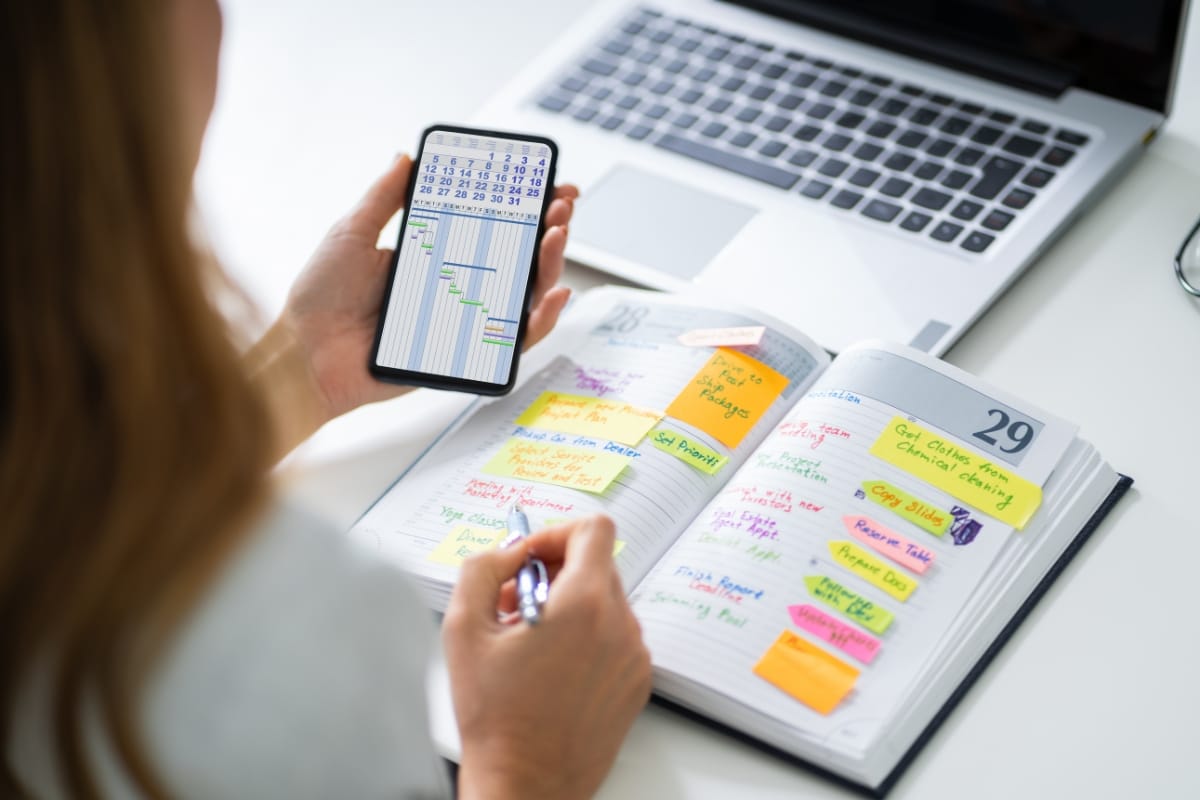
Allocating specific time slots for different tasks can significantly boost your productivity and minimize distractions in a remote work setting.
Using digital calendars enables you to manage your schedule efficiently, ensuring you focus on what matters. Don’t forget to regularly adjust your time blocks based on performance, allowing your behavior to adapt and optimize your work habits for even better results.
Allocate Specific Time Slots for Different Tasks
Allocating specific time slots for different tasks can transform your work routine, making it easier to stay organized and focused. By creating a well-structured schedule, you set clear expectations for what you aim to accomplish each day.
For instance, if you dedicate mornings to deep work, like analyzing data or writing reports, you’ll find that you’re less likely to let distractions pull you away during those critical hours.
Using digital calendars to block out time for specific tasks helps you keep track of your commitments and manage your workload more effectively. Consider treating your calendar like an appointment book, where you intentionally set aside slots for checking emails or attending meetings.
By being proactive about how you allocate your time, you can minimize interruptions and align your daily activities with your broader goals, enhancing productivity and clarity throughout your workday:
| Time Slot | Activity | Purpose |
|---|---|---|
| 9:00 – 10:30 AM | Data Analysis | Focus on critical insights |
| 10:30 – 10:45 AM | Break | Refresh and recharge |
| 10:45 – 12:00 PM | Respond to Emails | Clear your inbox |
| 12:00 – 1:00 PM | Lunch | Replenish energy |
| 1:00 – 3:00 PM | Project Work | Push ongoing tasks forward |
Use Digital Calendars for Effective Time Management
Using digital calendars is a game-changer when it comes to managing your time effectively. By setting aside specific time blocks for various tasks, you can clearly map out your day and minimize the chances of distractions veering you off course.
For example, if you allocate the first hour of your day for project work, you can dive deep into your tasks without constantly checking your emails or getting sidetracked by impromptu meetings.
Digital calendars like Google Calendar or Outlook make it easy to visualize your day and remind you of your commitments. You can set alerts so you’re always prompted when it’s time to switch tasks.
This structure allows you to focus on your work, knowing that you have dedicated time for everything on your plate, which can alleviate stress and keep you organized. Here’s how to maximize your time with a digital calendar:
- Block out specific times for deep work sessions.
- Set reminders for meetings and important tasks.
- Review and adjust your schedule weekly to stay flexible.
Regularly Adjust Time Blocks Based on Performance
Regularly adjusting your time blocks based on performance is a key strategy in maximizing your productivity and focus at work. This practice allows you to respond to how effectively you are accomplishing tasks, helping you allocate your time where it’s needed most.
For example, if you find that you’re consistently finishing data analysis in less time than planned, consider shortening that time block and reallocating the saved time to areas that require more attention, like project coordination.
Tracking your performance over time leads to a better understanding of your work rhythms and energy levels. By routinely evaluating how your time blocks align with your productivity, you’re able to fine-tune your schedule to fit your unique working style.
This approach not only minimizes distractions but also empowers you to create a work routine that enhances your effectiveness day after day:
| Task | Original Time Block | Revised Time Block |
|---|---|---|
| Data Analysis | 9:00 – 10:30 AM | 9:00 – 10:00 AM |
| Emails | 10:45 – 12:00 PM | 10:15 – 11:00 AM |
| Project Work | 1:00 – 3:00 PM | 11:15 – 1:00 PM |
Declutter Your Mind to Improve Concentration

Using mindfulness exercises can help you clear your thoughts, allowing you to stay focused throughout your workday. Practicing journaling is another effective way to manage stress and anxiety, giving you a better handle on your emotions.
Additionally, setting daily intentions provides mental clarity, ensuring your mind is primed for productivity. Let’s explore these easy strategies in detail.
Use Mindfulness Exercises to Clear Your Thoughts
Engaging in mindfulness exercises is a great way to clear your thoughts and improve your concentration at work.
Simple practices, like focusing on your breath for a few moments, can help you steer clear of distractions and feel more present in your tasks. By dedicating just five minutes to mindfulness, you can reset your mind, reduce anxiety, and enhance your overall productivity.
Incorporating mindfulness into your daily routine is easy and can make a big difference in your work performance. You might try guided meditation apps or take brief breaks to stretch and breathe deeply.
Such techniques can help you address overwhelming feelings and foster a sense of calm, ultimately leading to sharper focus on your goals and tasks at hand.
Practice Journaling to Manage Stress and Anxiety
Journaling is an effective way to manage stress and anxiety, helping you clear your mind and stay focused at work. When you take a few minutes to jot down your thoughts, fears, or daily challenges, you create a space for self-reflection and problem-solving.
This practice not only helps you process emotions but also reduces mental clutter, allowing you to tackle tasks with a clearer perspective.
Incorporating journaling into your daily routine can significantly enhance your productivity. For instance, you could set aside time at the beginning or end of your day to write down what’s on your mind.
This simple act helps you release stress and prioritize your tasks, making it easier to stay on track and avoid distractions throughout your workday.
Set Daily Intentions for Mental Clarity
Setting daily intentions is a straightforward yet powerful way to clear your mind and enhance your focus at work. Each morning, take a moment to think about what you want to accomplish that day.
This simple practice helps align your tasks with your goals, providing a clear roadmap and reducing the chances of distractions. For example, you might decide that today’s intention is to complete a specific project section by noon, ensuring you stay on track and engaged throughout the day.
By regularly setting daily intentions, you cultivate mental clarity that supports sustained concentration. This habit allows you to check in with yourself, enabling you to focus on what truly matters in your work.
As you orient your thoughts towards your intentions, you’re likely to feel less overwhelmed by tasks or interruptions. Here are some tips to help you get started:
- Take a few minutes each morning for reflection.
- Write down your intentions in a journal or planner.
- Review your intentions in the afternoon to stay motivated.
A clear mind opens the door to greater focus. To strengthen that focus, paying attention to your health is essential.
Stay Healthy to Boost Focus at Work

Maintaining a balanced diet, incorporating regular exercise, and ensuring adequate sleep are key factors in boosting your focus at work.
A nutritious diet fuels your body for sustained energy, while exercise can enhance your mood and concentration. Getting enough sleep helps your brain function optimally. Let’s dive into these essential aspects for achieving better focus and minimizing distractions.
Maintain a Balanced Diet for Sustained Energy
Maintaining a balanced diet is crucial for keeping your energy levels steady throughout the workday. Filling your plate with nutrient-dense foods like fruits, vegetables, whole grains, and lean proteins can help sharpen your focus and reduce fatigue.
For instance, snacking on nuts or yogurt can provide quick energy boosts without the sugar crash that comes from sugary snacks.
It’s all about fueling your body right to stay engaged and productive. Planning your meals ahead of time can make a huge difference; consider batch cooking healthy options for the week so you have nutritious meals ready when hunger strikes.
This way, you avoid the temptation of fast food or unhealthy snacks, keeping distractions at bay while enhancing your overall well-being:
- Incorporate more fruits and vegetables into your meals.
- Choose whole grains over refined grains for sustained energy.
- Include lean proteins like chicken, fish, or plant-based options.
- Stay hydrated with water throughout the day.
- Prepare healthy snacks to have on hand during work.
Incorporate Regular Exercise Into Your Routine
Incorporating regular exercise into your routine can significantly enhance your focus at work. Getting up for a quick walk or engaging in a short workout session boosts blood flow and energizes your mind, making it easier to stay engaged with your tasks.
For instance, setting aside just 20 minutes a day for physical activity can help clear mental fog, allowing you to tackle projects with renewed clarity and enthusiasm.
Consider taking breaks to stretch or do simple exercises during your workday. This not only helps refresh your mind but also combats the fatigue of prolonged sitting.
You might try using a standing desk or joining colleagues for a brief walk during lunch breaks to keep your energy levels high. Regularly integrating these small changes into your daily routine can make a noticeable difference in your concentration and overall well-being.
| Activity | Benefits | Frequency |
|---|---|---|
| Walking | Boosts energy and clears mind | Daily, 20 mins |
| Stretching | Reduces fatigue and tension | Every hour |
| Short Workouts | Enhances mood and focus | 3-4 times a week |
Ensure Adequate Sleep for Optimal Cognitive Function
Getting enough sleep is crucial for maintaining optimal cognitive function at work. A well-rested mind improves your focus, decision-making abilities, and overall productivity.
Think about how difficult it can be to concentrate when you’re fatigued; simply aiming for 7 to 9 hours of quality sleep each night can help you tackle your work tasks more effectively. You’ll notice that staying focused becomes easier when you’re alert and energized.
Establishing a consistent bedtime routine can enhance your sleep quality. Consider going to bed and waking up at the same time each day, even on weekends, to help regulate your body’s internal clock. By prioritizing sleep, you not only reduce distractions but also set yourself up for success during your work hours:
| Sleep Benefits | Impact on Work |
|---|---|
| Improves focus | More productivity and engagement |
| Enhances decision-making | Better problem-solving skills |
| Boosts mood | Creates a positive work environment |
Staying healthy helps you concentrate, but even the sharpest minds need a break. Learn how taking time away can recharge your focus and keep you performing at your best.
Take Regular Breaks to Recharge Your Mind

Recognizing signs of burnout and fatigue is key to maintaining your focus at work. Taking breaks to stretch, move, or meditate can help recharge your mind and enhance productivity.
Additionally, scheduling longer breaks each day provides essential refreshment to keep distractions at bay. These strategies will help you stay engaged and energized throughout your workday.
Recognize Signs of Burnout and Fatigue
Recognizing signs of burnout and fatigue is essential for maintaining focus at work. If you frequently feel exhausted even after a full night’s sleep, struggle with motivation, or find it hard to concentrate on tasks, these might be indicators that you need to take a step back.
Being aware of these signs helps you act promptly, allowing you to recharge before your productivity takes a further hit.
When you understand the signs of burnout, you can make informed choices about your work pace and break schedule.
For example, if you notice irritability or a lack of enthusiasm for projects, it might be time to incorporate regular breaks into your routine. By prioritizing short respites, you can boost your mental clarity and prevent distractions from overwhelming your day:
- Feelings of exhaustion despite adequate sleep
- Struggling with motivation and enthusiasm
- Difficulty concentrating on tasks
- Experiencing irritability or mood swings
- Recognizing the need for regular breaks
Use Breaks to Stretch, Move, or Meditate
Taking breaks to stretch, move, or meditate can significantly enhance your focus and energy levels at work. These simple actions help clear your mind, relieve tension, and improve your overall mood.
For instance, a quick walk around your office or a few minutes of stretching can reinvigorate your body and keep distractions at bay, making it easier to concentrate on your tasks.
Incorporating mindful meditation during your breaks is another effective way to recharge your mind. Just a few moments spent focusing on your breath can help reduce stress and provide clarity, making your return to work more productive.
Try setting a timer for five minutes and find a quiet spot to close your eyes and center your thoughts: whether it’s stretching, moving, or meditating, you’ll boost your cognitive function and enhance your ability to stay focused throughout the day.
- Take quick movement breaks to refresh your mind.
- Incorporate stretching to relieve tension and improve circulation.
- Practice meditation for a few minutes to enhance concentration.
Schedule Longer Breaks for Daily Refreshment
Scheduling longer breaks during your workday is a smart way to help you recharge and stay focused. Taking a substantial break, such as a 30-minute walk or a quiet moment with a book, allows your mind to reset, ultimately enhancing your productivity for the rest of the day. This isn’t just about stepping away; it’s about giving yourself a chance to refresh your brain, making it easier to tackle tasks once you’re back at your desk.
When you integrate these longer breaks into your routine, you create a space to disconnect from work and reduce stress levels. For example, use this time to grab lunch away from your desk or chat with colleagues about something non-work-related. This shift in your environment can help you return with a clearer mind and renewed energy, allowing you to concentrate better and minimize distractions throughout the day.
Taking breaks clears your head. With a fresh mind, you can see the truth about multitasking: it often slows you down instead of speeding you up.
Limit Multitasking for Increased Productivity

Focusing on one task at a time leads to better results and efficiency. You’ll learn how to use task switching strategically to enhance your workflow. It’s also important to recognize the downsides of multitasking, as it can create unnecessary stress and hinder concentration. Embracing these insights will help you stay focused and get more done in your workday.
Focus on One Task at a Time for Better Results
When you concentrate on one task at a time, you tap into your full potential for productivity. Multitasking might feel like a way to get more done, but it often leads to decreased efficiency and increased errors. Instead, try dedicating focused blocks of time to each task, allowing yourself to dive deeply into what you’re working on without constant distractions.
For instance, if you’re facing a report deadline, focus solely on that report during your scheduled work session. By eliminating other tasks during this time, you’ll notice how much clearer your thoughts become, leading to better outcomes. This focused approach not only conserves your mental energy but also reduces the stress that comes from juggling multiple projects at once:
| Task Type | Focus Approach | Expected Outcome |
|---|---|---|
| Report Writing | Dedicated session without interruptions | Greater clarity and effectiveness |
| Email Responses | Set time slots specifically for emails | Clearer communication and less stress |
| Project Planning | Focus solely on planning during this time | Better ideas and strategic execution |
Use Task Switching Strategically for Efficiency
Using task switching effectively can help you stay on track without the chaos that often comes with multitasking. Instead of bouncing between several projects at once, consider dedicating specific blocks of time to different tasks.
For example, if you need to handle emails and work on a report, follow a sequence where you spend a focused period on one and then switch to the other. This way, you maintain a sense of progress while still managing your workload efficiently.
Be mindful of how often you switch tasks, as excessive changes can lead to decreased focus. Aim to set clear boundaries around task-switching times.
You might set a timer for 30 minutes dedicated to one task before swapping to another, which allows for concentrated effort while minimizing distractions. This technique supports your goal of maximizing productivity and staying engaged throughout your workday:
- Dedicating specific time blocks for tasks
- Maintaining focus by minimizing task changes
- Using timers for dedicated work sessions
- Structured sequencing of tasks for better workflow
Recognize the Downsides of Multitasking
Multitasking often feels like a way to get more done, but it usually backfires by reducing your overall productivity. When you flip between tasks, your brain takes time to adjust, which can lead to mistakes and slower progress. For instance, if you’re drafting an email while trying to finish a report, the quality of both tasks may suffer, leaving you frustrated instead of successful.
Moreover, multitasking can increase your stress levels significantly. Juggling different tasks can create a chaotic work environment that makes it hard to concentrate. Instead of tackling several things at once, try focusing on one task until it’s done. This way, you can enhance your efficiency and feel a satisfying sense of accomplishment when you complete it:
| Task Type | Effect of Multitasking | Improved Strategy |
|---|---|---|
| Email Responses | Increased errors and miscommunication | Set dedicated time for emails |
| Report Writing | Slower completion and lack of clarity | Focus on writing without interruptions |
| Project Planning | Less thorough ideas and execution | Concentrate solely on project details |
Reducing multitasking clears the path to sharper focus, revealing the true value of your time. Next, let’s look at how technology can help keep those distractions at bay, letting you work smarter, not harder.
Leverage Technology to Minimize Distractions
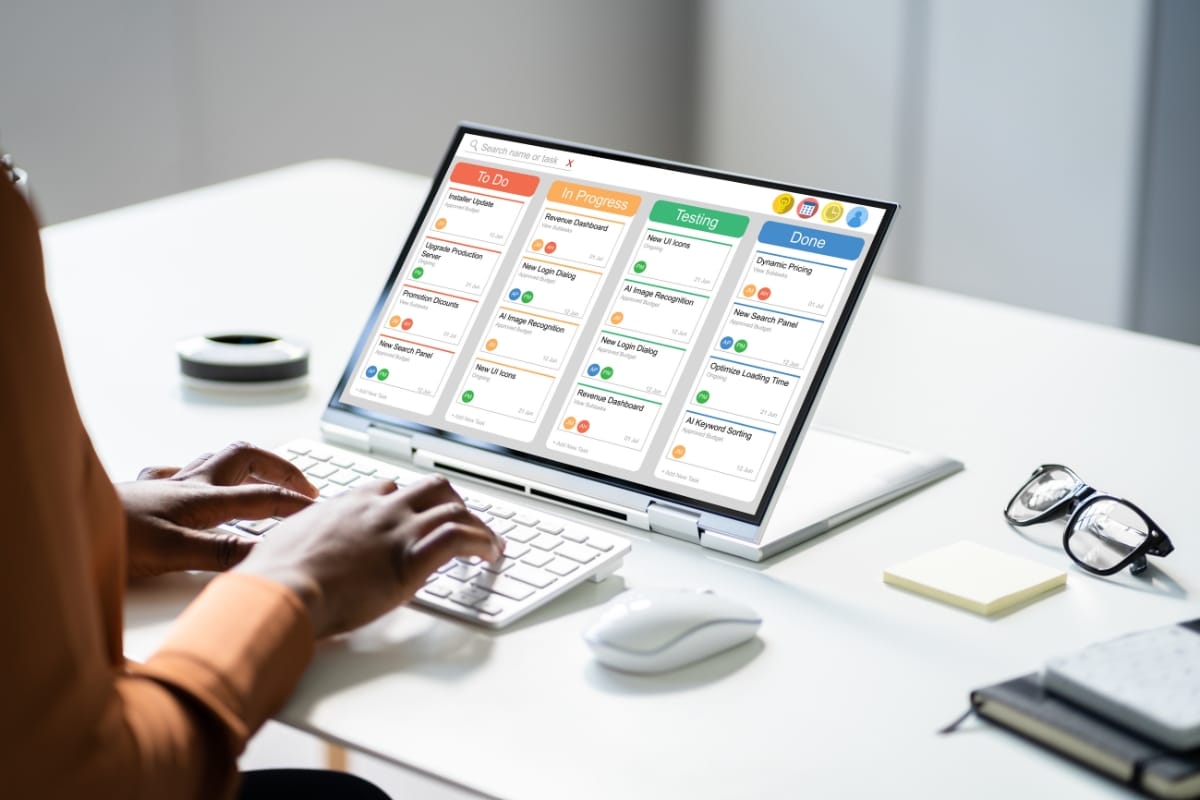
Using focus-enhancing apps and tools can significantly improve your ability to stay concentrated during work hours. Setting up notification controls will create a quieter digital environment, while website blockers can help cut out distractions that tempt you off task. Let’s dive into how these strategies can streamline your workday and keep you focused.
Use Focus-Enhancing Apps and Tools
Using focus-enhancing apps and tools can make a big difference in your ability to stay on task while working. For example, apps like Forest help you stay concentrated by allowing you to “plant a tree” that grows while you work, but withers if you pick up your phone. These tools not only reduce distractions but also create a fun and engaging way to maintain your focus throughout the day.
Another effective option is a website blocker, which lets you choose specific sites that typically steal your attention. By blocking temptations like social media during work hours, you create a more productive workspace. Setting these tools in place helps you manage your time better and keeps you aligned with your goals to minimize distractions:
- Focus-enhancing apps like Forest promote concentration.
- Website blockers prevent distractions from social media.
- Using productivity tools creates a more effective workspace.
Set Up Notification Controls for Digital Peace
Setting up notification controls on your devices can create a more peaceful digital environment at work. By silencing non-essential alerts from apps and social media, you can significantly reduce interruptions that disrupt your concentration. Take a moment to adjust your phone and computer settings; it’s an easy way to help maintain your focus throughout the day.
Another helpful approach is to schedule “do not disturb” hours during your workday. This allows you to block out distractions and dedicate undivided attention to critical tasks.
You’ll find that by limiting disruptions, you improve not just your productivity, but also your overall sense of calm while working. Consider the following steps to achieve digital peace:
- Adjust settings to silence non-essential notifications.
- Schedule specific times for alerts to minimize distractions.
- Create a focused environment by using “do not disturb” hours.
Implement Website Blockers to Reduce Temptations
Implementing website blockers is a smart move to keep distractions at bay while you work. By using tools like Freedom or Cold Turkey, you can customize settings to restrict access to tempting sites during your work hours.
This strategy helps create a focused environment, allowing you to direct your attention to tasks that truly matter instead of getting sidetracked by social media or other non-essential online activities.
Once you set up these website blockers, you’ll likely notice an immediate boost in your productivity. They serve as a gentle reminder to stay on course, making it easier for you to resist the urge to check your favorite sites. Plus, by minimizing digital distractions, you can enhance your workflow, leading to better outcomes in your projects and less stress during your day.
Delegate When Possible to Manage Workload

Identifying tasks suitable for delegation is a key step in managing your workload effectively. Next, training team members for shared responsibilities ensures everyone is on the same page.
Finally, communicating clearly about expectations is essential for successful collaboration. Each of these strategies plays a significant role in minimizing distractions and helping you stay focused at work while enhancing overall productivity.
Identify Tasks Suitable for Delegation
To maintain your focus at work, it’s vital to recognize which tasks you can delegate to others. For instance, if you’re swamped with administrative duties that take away from your core responsibilities, consider giving those tasks to a team member who could benefit from the experience.
By identifying these tasks, you not only lighten your workload but also empower others in the team to contribute and grow, creating a more collaborative environment.
Think about the daily tasks that consume your time but don’t necessarily require your unique skill set. Routine activities like data entry or scheduling meetings might be better handled by someone else, freeing you up to concentrate on more strategic and impactful projects.
This approach not only helps you stay focused but also improves your overall productivity, as you’re spending time on what truly matters to your role and the organization.
Train Team Members for Shared Responsibilities
Training team members for shared responsibilities is a smart move that helps lighten your workload while fostering collaboration. When you guide your colleagues through the skills needed for specific tasks, you not only create a versatile team but also encourage a sense of ownership and accountability.
For instance, if you’re frequently overwhelmed by project management duties, consider training someone to handle scheduling and communication updates. This allows you to focus on higher-priority tasks that need your unique expertise.
As you implement this training, be sure to set clear expectations and provide ongoing support. A quick reference guide or a shared document outlining key processes can make a significant difference, giving your team the tools they need to succeed.
Sharing responsibilities in this way not only reduces distractions for you but also promotes teamwork, leading to a more engaged and efficient work environment. By working together and leveraging each other’s strengths, you can minimize interruptions and keep your focus sharp.
| Training Aspect | Benefits | Tools/Methods |
|---|---|---|
| Task Delegation | Lightens workload and boosts focus | Guidance documents |
| Skill Development | Creates a versatile team | Workshops, online courses |
| Communication | Encourages teamwork and engagement | Shared platforms, regular check-ins |
Communicate Clearly About Expectations
Communicating clearly about expectations is essential for managing your workload effectively. When you delegate tasks, make sure to specify what needs to be done and the timeline for completion.
This reduces confusion and ensures that everyone is on the same page, allowing you to maintain focus on your top priorities without getting bogged down by miscommunication.
To further enhance collaboration, you might consider using shared documents or communication platforms where tasks and expectations can be outlined.
This way, team members can reference the information easily, and you can avoid the frustration of repeated questions. Clear communication not only fosters a productive environment but also boosts your team’s ability to tackle tasks while you stay focused on your core responsibilities.
Delegating tasks eases the burden and brings fresh perspectives to your work. Now, it’s time to reflect on your methods and adapt them, sharpening your focus for even greater success.
Reflect and Adapt to Improve Focus Strategies

To stay focused at work, regularly review your progress to see what’s effective and what needs adjusting. Identifying successful strategies allows you to hone in on methods that boost your productivity.
Also, staying open to new techniques can bring fresh energy to your routine and help clear distractions. Let’s explore how these practices can enhance your focus.
Review Your Progress Regularly
Regularly reviewing your progress is essential for staying focused at work and minimizing distractions. Set aside time each week to reflect on what strategies have worked for you and which ones haven’t.
This practice not only helps you understand your current productivity levels but also guides you in making necessary adjustments to enhance your focus and effectiveness during work hours.
Consider keeping a simple log or checklist to track your progress over time. For instance, note the tasks you completed each day and the methods that helped you stay engaged.
By analyzing these patterns, you can identify areas for improvement and celebrate your successes, reinforcing your motivation to stay on course. Use this check-in routine to create a more structured approach to managing distractions and boosting your productivity:
| Day | Tasks Completed | Effective Strategies | Notes |
|---|---|---|---|
| Monday | 3 | Time blocking | Felt productive |
| Tuesday | 2 | Minimized phone usage | Needed more breaks |
| Wednesday | 4 | Focused deep work session | Great energy levels |
Identify What Works and What Doesn’t
Identifying what strategies work for you is key to maintaining your focus at work. Take a moment to reflect on your daily routine and evaluate which methods helped you stay engaged and productive.
For instance, if you find that time-blocking your work for specific tasks resulted in clearer thinking and less distraction, that’s a strong indicator to continue using this approach. Recognizing successes like this allows you to build a personalized strategy that suits your unique needs.
It’s equally important to pinpoint what isn’t helping you focus. Maybe you noticed that checking emails too frequently pulled you away from crucial assignments, leading to frustration.
By acknowledging these habits, you can adjust your workflow to better manage your time and efforts. This reflection fosters an environment where you can continuously improve your productivity and stay on track with your goals.
Stay Open to New Methods for Staying Focused
Staying open to new methods for maintaining focus can significantly enhance your productivity at work. Trying different techniques, like the Pomodoro Technique or mindfulness exercises, can help you discover what works best to keep distractions at bay. Experimentation is key; it allows you to identify strategies that fit your unique workflow and help you stay engaged with your tasks.
As you explore fresh approaches, be sure to reflect on your experiences to gauge their effectiveness. For example, if you find that using focus-enhancing apps like Forest improves your concentration, you can incorporate them into your daily routine.
Embrace change, remain adaptable, and let trial and error guide you toward the best distractions minimization strategies suited to your work style.
You’ve put in the work to focus better. Now, it’s time to find someone who’ll keep you on track and help you stay steady.
Seek Accountability and Support to Maintain Focus

Partnering with colleagues helps you establish shared goals, providing motivation to stay on track. Joining accountability groups offers mutual support, making it easier to overcome distractions together.
Seeking feedback from peers on your focus strategies can enhance your methods and keep you accountable. Each of these approaches fosters a supportive environment that encourages concentration and productivity.
Partner With Colleagues for Shared Goals
Partnering with colleagues to set shared goals can give you that extra boost in staying focused at work. When you collaborate towards a common objective, not only do you hold each other accountable, but you also create a supportive environment that makes tackling distractions easier.
For example, if you and a teammate decide to tackle a project together with clear deadlines, you can check in regularly, which helps keep your motivation high and your focus sharp.
Engaging with your coworkers in this way also enhances communication and teamwork, making it less likely for interruptions to derail your progress. By sharing your goals, you can brainstorm strategies to overcome potential distractions, ensuring you stay aligned and productive.
This collaborative approach not only helps you maintain focus but also fosters a sense of camaraderie that can make your workday more enjoyable.
Join Accountability Groups for Mutual Support
Joining an accountability group can be a game changer when you’re looking to boost your focus at work.
Being part of a community where you share your goals and progress creates a supportive atmosphere that helps keep distractions at bay. You’ll find that regular check-ins with your peers not only hold you accountable but also provide encouragement, making it easier to tackle your tasks while staying focused.
In these groups, you can exchange strategies for overcoming challenges and celebrate each other’s successes, which can significantly enhance your motivation.
For example, if you’re struggling to stay on task, discussing your hurdles with others can bring fresh perspectives and new solutions. This collaborative environment fosters a sense of shared responsibility, allowing you to minimize distractions together and maximize productivity in your workday.
Seek Feedback From Peers on Focus Strategies
Seeking feedback from your peers on your focus strategies can be a game changer for your productivity. When you share your goals and challenges with colleagues, you open the door to practical insights that can enhance your approach to minimizing distractions.
For instance, if you’re struggling with staying focused during meetings, asking a coworker who excels in this area for tips can reveal effective techniques you might not have considered.
Moreover, regular check-ins with teammates not only reinforce your commitment but also create a sense of accountability that encourages you to stay on track. If you discuss your focus strategies with a buddy, you can exchange ideas and adjust your methods based on real experiences.
This collaborative interaction can boost morale and ultimately help you cultivate a more concentrated and efficient work routine.
Frequently Asked Questions
What are the best methods to set clear goals for focus at work?
To set clear goals for focus at work, define specific objectives, break them into manageable tasks, use the SMART criteria (Specific, Measurable, Achievable, Relevant, Time-bound), and regularly review your progress to maintain motivation.
How can I prioritize my tasks effectively to stay focused?
To prioritize tasks effectively, list them based on urgency and importance, then break down larger goals into smaller steps. This approach helps you stay focused and ensures you tackle what truly matters each day.
What is the Pomodoro technique and how does it enhance concentration?
The Pomodoro technique is a time management method that boosts concentration by breaking work into 25-minute focused intervals, called “Pomodoros,” separated by short breaks. This structure minimizes distractions, enhancing productivity and focus.
How can I declutter my workspace for better focus and productivity?
To declutter your workspace for improved focus and productivity, start by sorting through items, keeping only what you use daily. Organize remaining supplies in designated spaces and eliminate distractions to create a more streamlined and efficient environment.
What role does regular exercise play in improving focus at work?
Regular exercise boosts focus at work by enhancing blood flow to the brain, reducing stress, and improving overall mood. This leads to increased productivity and sharper concentration, helping you tackle tasks more effectively throughout the day.
Conclusion
Staying focused at work requires a combination of practical strategies, self-awareness, and a supportive environment. By minimizing distractions and implementing these techniques, you can significantly improve your productivity and job satisfaction.
For personalized guidance in fostering better focus and achieving your professional goals, trust Buttimer Consulting. Our expert team provides transformative speaking, coaching, and counseling services to help individuals and organizations thrive. Call us today at (404) 949-9500 to get started on your journey to greater workplace success!



